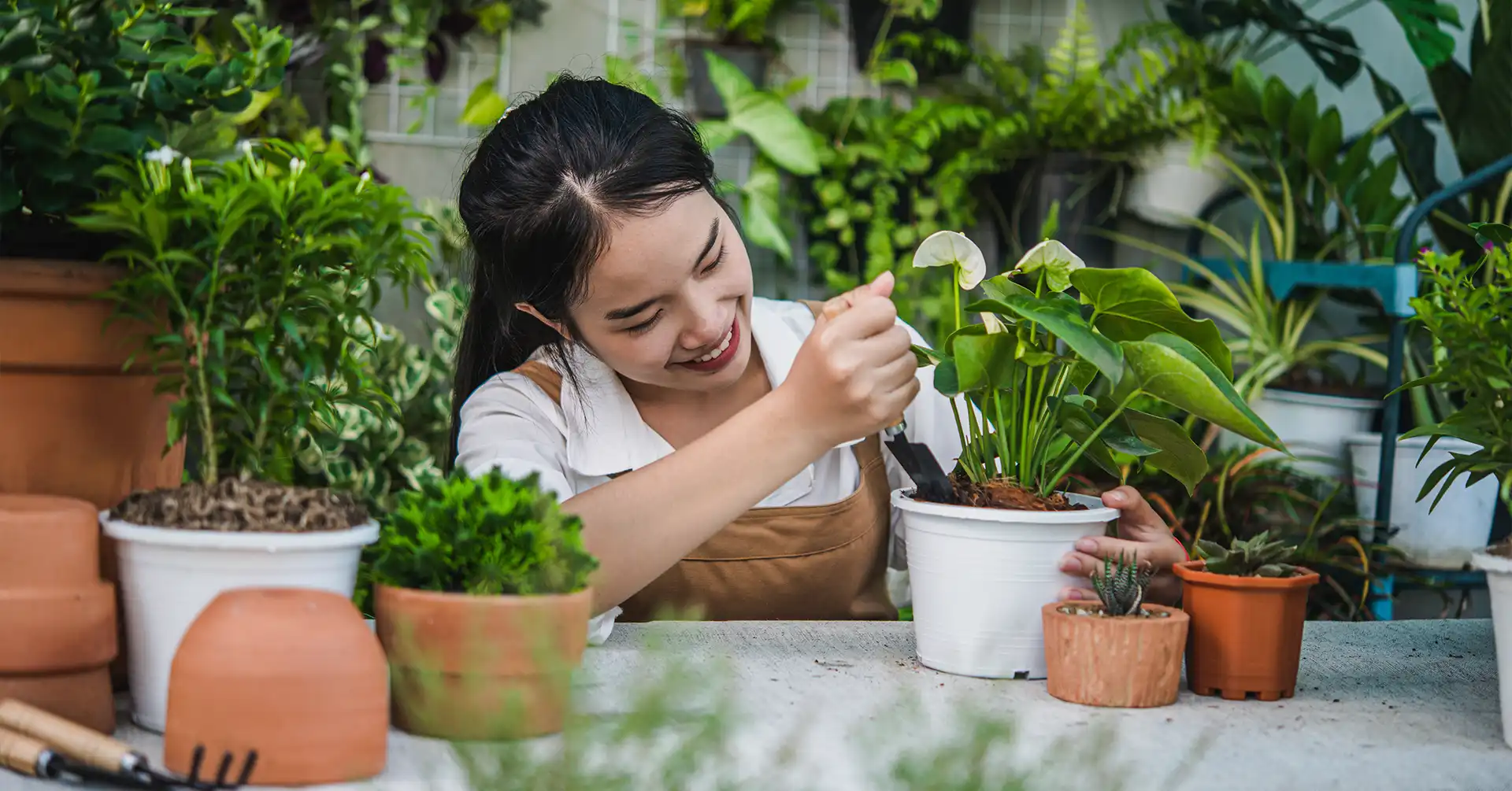City life may make it easy to feel detached from nature. Indoor gardening is easy and fun. Indoor gardening may turn your house into a green oasis that improves health and property value. In this complete guide, we’ll cover all you need to know to create an indoor garden, from plant selection to upkeep.
Selecting the Perfect Plants for Indoor Gardening
Indoor gardening begins with the most important step: choosing the proper plants. Indoor gardening offers several alternatives and enables the cultivation of many plant species, each with advantages. Here are some common indoor gardening methods:
Succulents and Cacti
These sand-dwelling species are good for beginners. Cacti and succulents thrive in arid conditions and need minimal maintenance once grown. They come in several forms, sizes, and colours to customize your indoor garden. Echeveria leaves are rosette-shaped, while Barrel Cactus spikes are tall and beautiful.
Herbs
Fresh herbs like basil, rosemary, thyme, and mint add flavour to cuisine and fill the air with delicious scents. Their practicality and fragrance make them ideal for indoor gardens. Imagine using basil leaves from your indoor herb garden to top your pizza or mint leaves to create mint tea.
Spider Plants (Chlorophytum comosum)
Spider plants are gorgeous and air-purifying, making them popular houseplants. Their white and green-striped arching foliage provides aesthetic appeal to any environment. They generate “spiderettes,” or small plants ideal for organically growing indoor gardens.
Peace Lilies (Spathiphyllum)
These high-tech plants are loved for their white flowers and air-cleaning abilities. Peace lilies can flourish in dim to bright environments, making them a great choice for low-light locations. Their towering white bracts, symbolizing purity and tranquillity, will calm your indoor garden.
Snake plants
Tall, vividly patterned leaves characterize snake plants. These plants are attractive and low maintenance. They also filter air well, making them ideal for indoor gardens. The snake plant’s architecture immediately enhances any environment.
Creating the Perfect Indoor Garden Setting
After choosing houseplants, create your dream indoor garden. How to do it stylishly and functionally:
location
Place your plants in a well-lit area. Many plant species have light requirements. Learn about your plants’ lighting requirements to keep them healthy and growing. They may be grown under dimmable LED grow lights or near windows with see-through curtains to avoid overexposure to sunlight.
Containers Matter
Choose pots and containers that match your decor. Root rot from overwatering may be prevented with proper drainage. Hanging baskets, basic terracotta containers, creative ceramic pots, or a combination will elevate your interior garden. Consider your home’s containers an extension of the design.
Nutrients and soil
Make sure your potting soil is high-quality and suited for your plants. Organic elements like compost and peat moss may increase soil texture and water retention. Feed your indoor garden periodically using a balanced, water-soluble fertilizer to maintain plant health. Indoor garden soil provides all the nutrients for development, so consider it the foundation.
Arrange Thoughtfully
Plants in a symmetrical arrangement may beautify your indoor garden. When building an eye-catching display, consider your plants’ size and color. Grouping plants with similar care needs may simplify upkeep and ensure healthy growth. Consider your indoor garden a living piece of art where each plant was chosen to enhance the room’s beauty.
How to Maintain Indoor Gardens?
Indoor gardening goes beyond planting seeds in pots and letting them decay. Your indoor oasis’s success depends on regular care. Here’s a houseplant health cheat sheet:
Water Wisely
Amateur indoor gardeners often overwater plants. Water your plants according to their demands and submerge rather than overwater to prevent this. Putting a saucer beneath each plant to catch excess water may help avoid root rot. Moisture meters let you know when to water your plants.
Remove and Reduce
Cut down overgrown branches and remove yellow or dead leaves to keep plants tidy and healthy. Regular pruning may encourage new growth and improve the appearance of your indoor garden. You can manage plant form and size with consistent trimming.
Bug Control
Bug control in indoor gardening takes effort. Spider mites, aphids, and mealybugs are frequent houseplant pests. If you find any, use insecticidal soap or other natural methods to destroy them immediately. Regularly checking the plant’s leaves and stems will help you discover pests early.
Rotate for Even Growth
Rotate your plants regularly for healthy, equal growth. Preventing plants from extending or leaning towards a light source may encourage balanced growth. Rotating plants every few weeks ensures they receive equal light.
Enjoy the process
Indoor gardening has psychological advantages as well. Celebrate your plants’ development and the natural beauty they’ve brought into your house. Learning about your houseplants may reduce stress and increase your connection to nature. Keep a log of your plant’s development and upkeep.
Indoor gardening benefits
Indoor gardening provides many functional advantages as well as aesthetic rewards. It may substantially impact health and life quality.
Improve Our Air
Many houseplants filter formaldehyde, benzene, and xylene from the air. Healthy indoor air and a nicer environment may result. Plant-filtered air may relieve many respiratory and allergy diseases.
Stress-release
Indoor gardening may reduce stress and promote mental wellness. Numerous studies show that indoor plants decrease blood pressure tension and enhance relaxation. An interior garden may make a home a peaceful retreat.
Productivity and creativity
Workplace greenery boosts productivity and creativity. Indoor gardening may help one concentrate and cleanse one’s thoughts. You may enhance your productivity and get the advantages of having a small indoor garden by putting it on your desk or nearby.
Joyful Nature
Indoor gardening gives city people a daily connection to nature when they can’t go outdoors. It makes us joyful and reminds us of our connection to nature. Your home garden will become a living tribute to nature’s beauty, strengthening your connection.
Creative Indoor Garden Ideas
Vertical Gardens
- Vertical gardens save room in small homes. Vertical gardens may be built using wall-mounted planters, hanging pots, or kits.
- Vertical garden design must consider plant growth habits and light. Plants that like shade should be near the bottom of the bed, while those that want sun should be higher.
- Succulents, ferns, herbs, and trailing vines are popular vertical garden plants. Combining plant species may make an attractive arrangement.
Terrariums
- Terrariums, miniature self-sustaining ecosystems, vary in form, size, and design. Gravel, activated charcoal, soil, and plants alternate in a normal glass container.
- For a viable terrarium, consider plants with comparable lighting and moisture needs. Succulents, mosses, and Tillandsia (air plants) populate terrariums.
- Remember that terrariums require less watering since they are enclosed. Overwatering might destroy the plant by causing mold.
The Bonsai
- The Japanese art of bonsai manipulates small trees to give them the appearance of age and beauty. The Japanese maple, ficus, and juniper are common bonsai trees.
- Bonsai trees require regular branch cutting, wiring, and repotting to be healthy. They may grow into garden art you’re proud of.
- Beginners may benefit from joining a bonsai group or asking experienced hobbyists for advice.
Indoor Herb
- An indoor herb wall is useful and attractive. It makes cooking with fresh herbs easier and fills the air with a relaxing scent.
- Indoor herb gardens grow basil, rosemary, mint, and parsley. Make sure they get adequate sunshine; if not, use grow lights.
- Use attractive, consistent pots or containers and label them to assist people in locating what they need.
Fairy garden
- Creating a fairy garden lets you imagine. Miniature plants, figurines, and other elements may form different-sized landscapes.
- Dwarf succulents, tiny ferns, and microscopic ground coverings are common fairy garden plants.
- Add miniature furniture, animals, and LED lights to personalize and enchant your fairy garden.
Aquatic Indoor Garden plan
- Installing an indoor aquatic garden can soothe any environment. You can turn a pot or aquarium into a home pond with the correct aquatic plants.
- Indoor aquatic gardens grow water lilies, lotuses, and various ferns. Add a little pump or filter to clean and oxygenate the water.
- Aquatic plants and water may calm you within.
Expanding Your Plant Collection
- Finding uncommon and exotic plants is one of the most exciting parts of indoor gardening. Add carnivorous plants, air plants (Tillandsia), exotic succulents, and orchids to your collection.
- Joining a local plant club or online community gardening forum lets gardeners meet others and share cuttings of their favourite plants.
- Before adding a new species to your collection, understand that each species has distinct care needs.
Conclusion
Indoor gardening brings nature inside and has numerous advantages. Studying and picking acceptable plants, building a sufficient garden area, and maintaining your interior sanctuary may become a healthy and peaceful retreat.
Whether you’re an expert or a beginner, your garden may provide delight, tranquillity, and inspiration for years. Introduce nature’s beauty. This will enhance your life and foster a healthy, long-term connection with nature.
Also Read:
Patio Ideas: Small Budget Ideas In 2023






